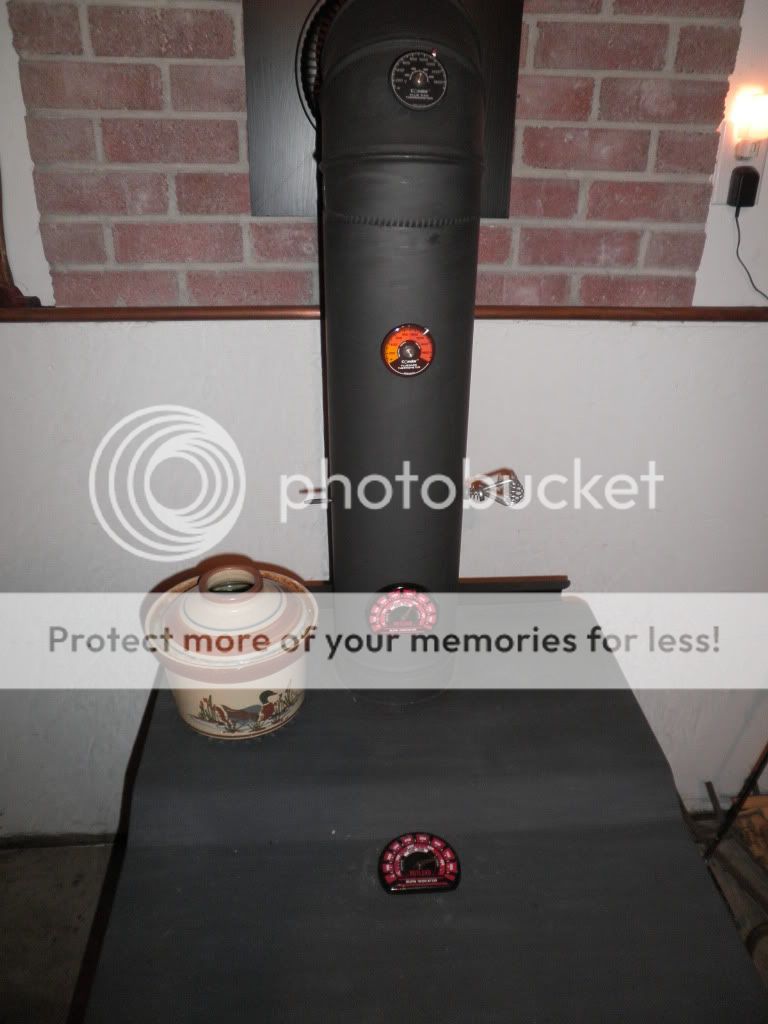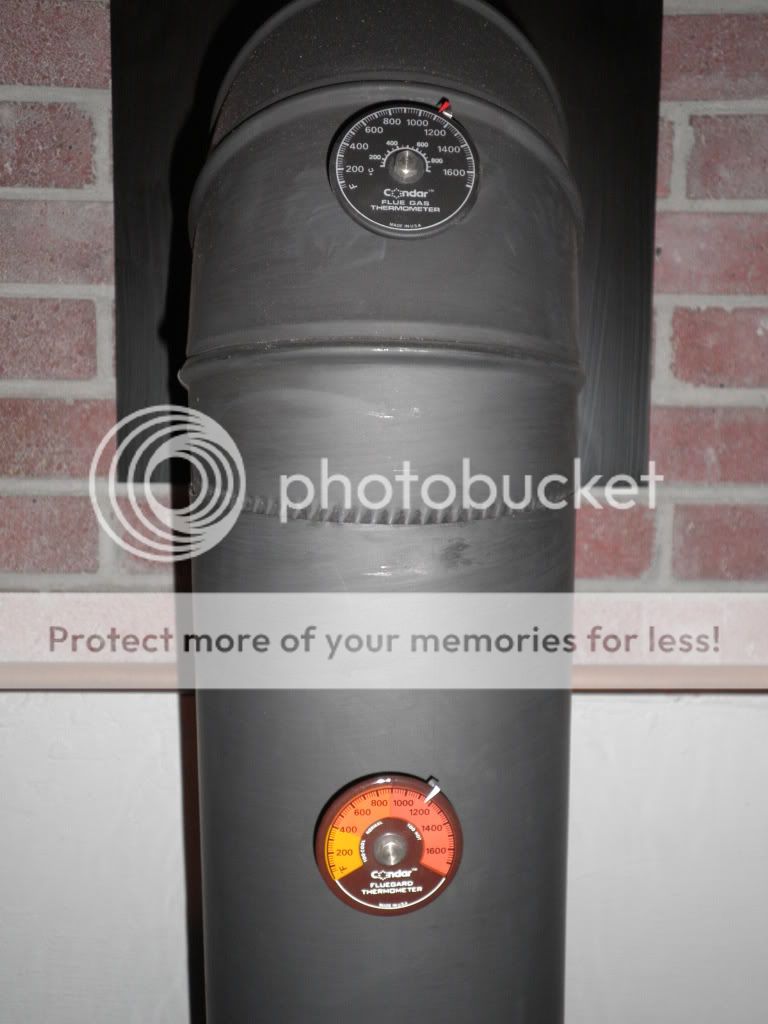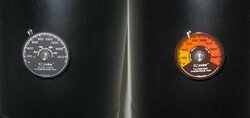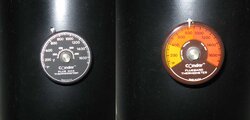3-39 Condar Probe vs. 3-19 Condar Probe. Test Results.
- Thread starter pen
- Start date
-
Active since 1995, Hearth.com is THE place on the internet for free information and advice about wood stoves, pellet stoves and other energy saving equipment.
We strive to provide opinions, articles, discussions and history related to Hearth Products and in a more general sense, energy issues.
We promote the EFFICIENT, RESPONSIBLE, CLEAN and SAFE use of all fuels, whether renewable or fossil.
You are using an out of date browser. It may not display this or other websites correctly.
You should upgrade or use an alternative browser.
You should upgrade or use an alternative browser.
- Status
- Not open for further replies.
Todd
Minister of Fire
Pull it out of the pipe an inch Pen. Mine reads right in line with Woodstocks thermocouple tests, so i'm leaving mine that way.
4000 hour life just sounds wrong but if Condar says so maybe Begreens probe is past it's prime? Oops, left Begreen open on that statement. :lol:
4000 hour life just sounds wrong but if Condar says so maybe Begreens probe is past it's prime? Oops, left Begreen open on that statement. :lol:
Very interesting Pen. I have not touched my thermometer. It went from factory to flue, so this does make one wonder about calibration of these units. It may need to be checked against a reference probe like WES999's if you want the actual factual temps.
BeGreen said:Very interesting Pen. I have not touched my thermometer. It went from factory to flue, so this does make one wonder about calibration of these units. It may need to be checked against a reference probe like WES999's if you want the actual factual temps.
Ah, that's not necessary.
Just hate coming up with more questions and no clear answers.
pen
Todd said:Pull it out of the pipe an inch Pen. Mine reads right in line with Woodstocks thermocouple tests, so i'm leaving mine that way.
4000 hour life just sounds wrong but if Condar says so maybe Begreens probe is past it's prime? Oops, left Begreen open on that statement. :lol:
I've mentioned using a spacer like you have or insulator to Condar but I they didn't seem interested. Probably because that means a package change which I would assume is more difficult than a printing update.
pen
Pen and I have exchanged probes to compare temps in differing flue setups. I ran some tests on our double-wall pipeand found that at 300 °F my older probe and Pen's new probe agree, both reading the same. But as the temps warmed up, they started to depart. I think this pretty well confirms what we have been saying. The newer Condar probes appear to be reading high at temps above around 500 °F. By time our flue was reading 700F steady on the 3-19, it was reading about 825F on the 3-39.
A thermometer should be consistent across its rated range. Instead, it looks like the newer Condar bimetalic springs are wound slightly different giving progressively higher readings at higher temps. This is troubling. We've had a lot of folks getting unnecessarily worried about their stove when it could working just fine.
A thermometer should be consistent across its rated range. Instead, it looks like the newer Condar bimetalic springs are wound slightly different giving progressively higher readings at higher temps. This is troubling. We've had a lot of folks getting unnecessarily worried about their stove when it could working just fine.
Attachments
Nothing like having our speculations confirmed.
I think their testing method at the factory needs to change as it's not realistic enough to use a thermocycler.
pen
I think their testing method at the factory needs to change as it's not realistic enough to use a thermocycler.
pen
Todd
Minister of Fire
Peter B.
Feeling the Heat
pen & BeGreen:
Thanks for your persistence with this...
Without reviewing this thread (or others related) I seem to recall that Condar recently 'disowned' their claims about the FluGard's (3-39) accuracy when used with single wall pipe... but they maintained it was accurate for double wall.
It would appear they have more work to do 'correcting' their literature.
I just wish they'd correct their probe's accuracy instead.
Peter B.
-----
Thanks for your persistence with this...
Without reviewing this thread (or others related) I seem to recall that Condar recently 'disowned' their claims about the FluGard's (3-39) accuracy when used with single wall pipe... but they maintained it was accurate for double wall.
It would appear they have more work to do 'correcting' their literature.
I just wish they'd correct their probe's accuracy instead.
Peter B.
-----
M
mhrischuk
Guest
It's really not difficult to make a thermometer accurate. Making it accurate and be able to sell it at a price point that generates high profit is the hard part. That is what is on the manufacturers top of the list.
Are there alternatives? A little higher cost but more accuracy?
My Dodge diesel has a pyrometer. It's a "K" type that reads from 328F to 2282F. For anyone interested, you don't want your exhaust gas temps to exceed 1250F for long durations or you begin to soften the pistons.
Are there alternatives? A little higher cost but more accuracy?
My Dodge diesel has a pyrometer. It's a "K" type that reads from 328F to 2282F. For anyone interested, you don't want your exhaust gas temps to exceed 1250F for long durations or you begin to soften the pistons.
Highbeam
Minister of Fire
That pyro for your truck costs about 150-200$. These flue meters are 15-20$. That's where accuracy can be compromised.
M
mhrischuk
Guest
Highbeam said:That pyro for your truck costs about 150-200$. These flue meters are 15-20$. That's where accuracy can be compromised.
How accurate does it need to be? If the 15-20 dollar unit isn't accurate enough than why use it?
Highbeam
Minister of Fire
Condar is the only game in town. The issue is whether it is accurate enough for use and until this thread showed us the error, nobody knew that these meters weren't 100% accurate.
We are stove geeks her and require more than the standard level of accuracy. This thread also gives us the ability to create a conversion chart to account for the non-linear error in the OEM condar probe meter gauge. If you can produce a 30$ gauge that is extremely accurate then I would buy one. Until then, we are making do with what we have.
We are stove geeks her and require more than the standard level of accuracy. This thread also gives us the ability to create a conversion chart to account for the non-linear error in the OEM condar probe meter gauge. If you can produce a 30$ gauge that is extremely accurate then I would buy one. Until then, we are making do with what we have.
M
mhrischuk
Guest
There are some alternatives, but we don't have a lot of comparison data on them yet:
http://www.imperialgroup.ca/stove_stovepipeaccessories.cfm?c=77
http://www.fleetfarm.com/catalog/pr...rolet-magnetic-chimney-thermometer-with-probe
Based on this being a perennial question I think I will buy one of each and test them vs the old style Condar 3-19 thermometer this fall.
http://www.imperialgroup.ca/stove_stovepipeaccessories.cfm?c=77
http://www.fleetfarm.com/catalog/pr...rolet-magnetic-chimney-thermometer-with-probe
Based on this being a perennial question I think I will buy one of each and test them vs the old style Condar 3-19 thermometer this fall.
certified106
Minister of Fire
BeGreen said:There are some alternatives, but we don't have a lot of comparison data on them yet:
http://www.imperialgroup.ca/stove_stovepipeaccessories.cfm?c=77
http://www.fleetfarm.com/catalog/pr...rolet-magnetic-chimney-thermometer-with-probe
Based on this being a perennial question I think I will buy one of each and test them vs the old style Condar 3-19 thermometer this fall.
Looking forward to seeing the data. I think this fall when I light my stove up I will grab one of our high temp digital thermocouples from work and verify how accurate my probe is.
Todd
Minister of Fire
I tried the SBI last year on single wall pipe and compared to the condar probe it was about 50-100 degrees less at cruising temps. I also found both probes to be more accurate on single wall pipe if you pull them out about an inch. Woodstock sent me a spread sheet from an all day burn with thermo couple flue temps to compare mine and they were very similar.
I keep switching back between probes and surface thermometers, someday I'll probably go to a thermocouple setup but I just don't like the looks of wires hanging out and a big digital read out box. I guess manufactures don't think there is much money to make in a real accurate thermometer for wood stoves, most people don't even use one.
I keep switching back between probes and surface thermometers, someday I'll probably go to a thermocouple setup but I just don't like the looks of wires hanging out and a big digital read out box. I guess manufactures don't think there is much money to make in a real accurate thermometer for wood stoves, most people don't even use one.
I spoke with Condar and quite frankly I wish they were more receptive to outside feedback. The new thermometers have lower wife appeal (more garish) and are not accurate in the higher temp ranges. But still they are doggedly persistent that they know better than their customers what is good for them.
tfdchief
Minister of Fire
BG, I have both Condors and the SBI. I have only used the original Condor so far. I was going to compare last winter but ran out of time. I also found the SBI would not fit in the hole I drilled for the Condors. It was slightly bigger. I will be interested to see what you come up with.
Sounds good chief. I'm finding some other alternatives as I search farther afield. Some may need adapting:
pizza oven thermos:
http://www.cooper-atkins.com/productspecsheet.asp?pid=43
http://www.fornobravo.com/store/Door-Thermometer-for-Wood-Oven-p-16335.html
Tempoint 12-7014 thermometer probe , courtesy of xclimber:
http://www.professionalequipment.co...ermometer-tempoint-12-7014/dial-thermometers/
I've always been partial to TelTru equipment:
http://www.teltru.com/p-449-gt225-back-connect-thermometer-2-inch-dial-with-18-inch-npt.aspx
pizza oven thermos:
http://www.cooper-atkins.com/productspecsheet.asp?pid=43
http://www.fornobravo.com/store/Door-Thermometer-for-Wood-Oven-p-16335.html
Tempoint 12-7014 thermometer probe , courtesy of xclimber:
http://www.professionalequipment.co...ermometer-tempoint-12-7014/dial-thermometers/
I've always been partial to TelTru equipment:
http://www.teltru.com/p-449-gt225-back-connect-thermometer-2-inch-dial-with-18-inch-npt.aspx
tfdchief
Minister of Fire
Interesting alternatives. I like the last one.BeGreen said:Sounds good chief. I'm finding some other alternatives as I search farther afield. Some may need adapting:
Todd
Minister of Fire
I've been tempted more than once to get one of those Teltru probes. There is a member here who has one but he did peg it out a couple times and doesn't know if it effected the accuracy. Wish they made one that goes up to 2000.
If my trusty Sandhill ever gives up the ghost, I'll prolly get the TelTru magnetic surface thermometer. I like the classic black numbers on white behind a glass bezel.
Todd
Minister of Fire
BeGreen said:If my trusty Sandhill ever gives up the ghost, I'll prolly get the TelTru magnetic surface thermometer. I like the classic black numbers on white behind a glass bezel.
I like those as well but do you think they would be that much more accurate than any other surface thermometer?
They should be more precise, but I don't own own so I can't say for sure. Our Sandhill has stayed pretty accurate and it is quite old. What I also like about both is that they are less vulnerable to needle bending and look a lot classier.
- Status
- Not open for further replies.
Similar threads
- Replies
- 2
- Views
- 873
- Replies
- 6
- Views
- 1K
- Replies
- 6
- Views
- 605
- Replies
- 0
- Views
- 1K





